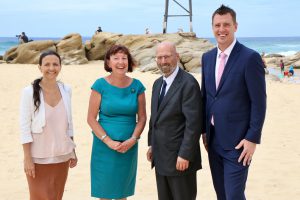Lifeguards on several NSW beaches will soon have access to detailed condition reports as part of a world-first beach safety initiative.
Sensors and a mix of other smart infrastructure will monitor wave and swell movements and provide earlier detection of dangerous conditions under the project involving four Sydney and Lake Macquarie beaches.
The Smart Beaches Project aims to curb the growing number of drownings along the New South Wales coast.
Almost 11 million people visited the patrolled beaches of Lake Macquarie and Northern Beaches Councils in the 2017-18 season, which saw 1,600 rescues and 7,200 people requiring first aid.
Nationally there have been 97 reported drowning deaths in Australia so far this summer compared to 64 last year, according to Royal Life Saving Australia.
Under the new initiative, smart sensors will monitor beach activity to gauge which beaches and amenities are busiest and then transmit the data to lifeguards and local councils.
The project, which received $910,000 through the Commonwealth’s Smart Cities and Suburbs Program, will see the technology piloted throughout the next 12 months.
Lake Macquarie City mayor Kay Fraser said Redhead Beach and Blacksmiths Beach had been selected as the city’s two pilot locations.
“Both are very popular beaches; each with unique circumstances that will test this technology and how it is applied,” Cr Fraser said.
“Already this summer we have seen a disturbing number of drowning deaths along Australia’s coast. In NSW alone, there have been 16 coastal drownings since the start of summer.”
Northern Beaches mayor Michael Regan said collecting beach usage information was a time-consuming and imprecise task for professional lifeguards but the project would help by providing accurate information.
Manly and Shelly beaches in Sydney, which will also host the trial, were very busy beaches attracting high numbers of both locals and tourists, Cr Regan said.

Surf Life Saving NSW, the Australian Professional Ocean Lifeguards Association and the Australian Coastal Councils Association are among more than a dozen other project partners.
University of Technology Sydney Associate Dean, External Engagement, Professor Myriam Amielh said the technology would be developed and trialled over the next 12 months, with plans to roll it out by mid-2020.
“Pending the success of this trial and ongoing funding, the technology could be rolled out to other beaches nationally and internationally,” Professor Amielh said.
“Development of this technology is in its early stages, but it has the potential to become an invaluable tool in ongoing efforts to improve beach safety and usability.”
Other funders of the project include Lake Macquarie City Council, Northern Beaches Council and University of Technology Sydney.
Comment below to have your say on this story.
If you have a news story or tip-off, get in touch at editorial@governmentnews.com.au.
Sign up to the Government News newsletter.




Leave a Reply